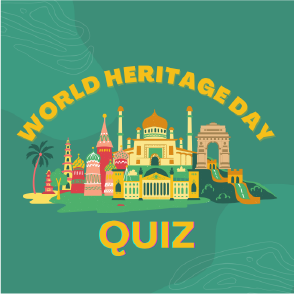As educators, we do more than teach subjects—we shape perspectives, instill values, and nurture curiosity. On World Heritage Day (April 18), we have a unique opportunity to introduce our students to our world’s cultural and natural wonders, especially those within our own country. Our heritage is not just about monuments and historical sites; it is a bridge between the past and the future. As teachers, we are responsible for ensuring that this bridge remains strong and well-preserved for generations to come.
World Heritage Day serves as a reminder of the need to protect and promote cultural and natural heritage. Established by UNESCO and the International Council on Monuments and Sites (ICOMOS), the day aims to foster awareness about preserving historical sites that define civilizations. India, with its 40 UNESCO World Heritage Sites, offers a vast learning ground for students to explore history, architecture, and traditions. These sites are not merely relics of the past but hold deep connections to our identity and continuity as a society. However, with modernization, urbanization, and environmental threats, many of these sites face challenges. As teachers, we can play a pivotal role in ensuring that students understand the significance of heritage conservation and take an active part in its preservation.
One of the most powerful ways to inspire students is by making heritage education relatable and engaging. Traditional classroom methods may not be enough to truly connect students to the essence of these sites. Instead, creative storytelling, real-life examples, and interactive activities can help bridge the gap. By nurturing curiosity and an appreciation for heritage, educators can empower students to become the future guardians of history. Whether it is through school projects, art, or digital storytelling, students can be encouraged to take small yet meaningful steps in safeguarding their heritage. Ultimately, preserving our past is not just about protecting old monuments but about maintaining a cultural identity that will continue to inspire generations to come.

Why World Heritage Day Matters?
World Heritage Day, officially known as the International Day for Monuments and Sites, was established by UNESCO to promote awareness about the importance of heritage conservation. India, with its 40 UNESCO World Heritage Sites, is a treasure trove of history, culture, and biodiversity. From the majestic Taj Mahal to the ancient Ajanta and Ellora Caves, and from the spiritual city of Varanasi to the breathtaking Sundarbans, our heritage reflects the diversity and richness of our civilization. However, preserving these sites is not just the duty of archaeologists or historians; it is a responsibility we all share—including students and educators.
India’s rich and diverse cultural and natural heritage offers an incredible resource for education. World Heritage Day serves as a significant opportunity to raise awareness about the importance of these sites and the efforts required for their preservation. Many of these sites have witnessed centuries of history, cultural exchanges, and artistic evolution. For instance, the Ajanta Caves, dating back to the 2nd century BCE, are a testament to India’s artistic brilliance, while the Kaziranga National Park is a symbol of our commitment to biodiversity conservation. By incorporating heritage education into the curriculum, teachers can help students appreciate the historical, architectural, and ecological value of these places.
It is crucial to understand that heritage conservation is not limited to preserving old buildings. It includes the protection of intangible cultural heritage, such as folk traditions, festivals, and linguistic heritage. Teachers can play a pivotal role in fostering this awareness among students by encouraging discussions, organizing field visits, and utilizing modern technology to explore history. The more students engage with their heritage, the more likely they are to respect and protect it. Educators can also discuss how heritage sites face threats from environmental changes, urbanization, and neglect. By instilling a sense of responsibility, teachers can shape young minds into becoming advocates for cultural preservation, ensuring that the legacy of our past remains alive for the future.
Teaching Heritage in the Classroom
Heritage education should not be limited to textbooks and history lessons. As teachers, we can make learning about heritage engaging and meaningful. Here’s how:
- Storytelling: Narrating fascinating stories about historical sites can capture students’ imagination. For instance, the legend of Emperor Shah Jahan and the Taj Mahal or the valor of the Rajputs at Chittorgarh Fort can make history come alive.
- Field Trips: Organizing visits to nearby heritage sites can create an immersive learning experience. If physical trips aren’t possible, virtual tours offered by platforms like Google Arts & Culture can be a great alternative.
- Creative Assignments: Encouraging students to create art, poetry, or presentations about heritage sites fosters deeper engagement. A group project on “Unsung Heritage Sites of India” can open their eyes to lesser-known treasures.
- Debates & Discussions: Hosting debates on topics like “Should historical monuments be modernized?” or discussions on heritage conservation policies can enhance critical thinking skills.
Encouraging Students to be Heritage Guardians
While learning about heritage is essential, inspiring students to actively participate in its conservation is equally important. Here are a few ways teachers can cultivate a sense of responsibility among students:
- Adopt a Monument Initiative: Encourage students to ‘adopt’ a local heritage site by regularly visiting, documenting, and spreading awareness about its history and significance.
- Heritage Clubs: Form a school-based heritage club where students can participate in conservation drives, photography contests, or storytelling sessions related to heritage.
- Social Media Campaigns: Guide students to use digital platforms to create awareness. They can write blog posts, make short videos, or share fun facts about historical places.
Technology and Heritage Conservation
In today’s digital era, technology offers innovative ways to explore and preserve heritage. Teachers can introduce students to tools like:
- Augmented & Virtual Reality (AR/VR): Many museums and heritage organizations offer AR/VR experiences that allow students to virtually walk through ancient ruins or restored palaces.
- Digital Archives: Websites like UNESCO’s World Heritage List and Indian National Trust for Art and Cultural Heritage (INTACH) provide access to vast digital resources on historical sites.
- Gamification in Learning: Educational apps and games, such as Google Expeditions or heritage-based quizzes, make learning more interactive and fun.
World Heritage Day Quiz: Indian Heritage Edition
Making Every Student a Heritage Ambassador
As teachers, our role extends beyond the classroom. By instilling an appreciation for heritage, we are shaping responsible citizens who value and protect their history. Let us take this World Heritage Day as a reminder that the past is not just to be remembered but also preserved for the future. By integrating heritage education into our teaching methods, we can empower students to become ambassadors of cultural preservation.
So, the next time you discuss a historical event or a cultural landmark in class, remember—you’re not just teaching history, you’re safeguarding the legacy of the world. And that, perhaps, is one of the most impactful lessons of all.
Happy World Heritage Day!
FAQs about World Heritage Day
- What is the purpose of World Heritage Day?
World Heritage Day aims to promote awareness about cultural and natural heritage and encourage conservation efforts globally. - How many UNESCO World Heritage Sites are in India?
India has 40 UNESCO World Heritage Sites, including cultural, natural, and mixed heritage sites. - How can students contribute to heritage conservation?
Students can participate in heritage clubs, adopt monuments, raise awareness through social media, and engage in conservation activities. - Why is heritage preservation important?
Heritage preservation helps maintain cultural identity, promotes tourism, and ensures that future generations can learn from historical sites. - What role do teachers play in heritage conservation?
Teachers educate students about heritage, inspire conservation efforts, and encourage active participation through projects and discussions.




